Elite life

Mushrooms
Leccinum
║ Mushrooms ║
Red-Capped Scaber Stalk (Leccinum aurantiacum)
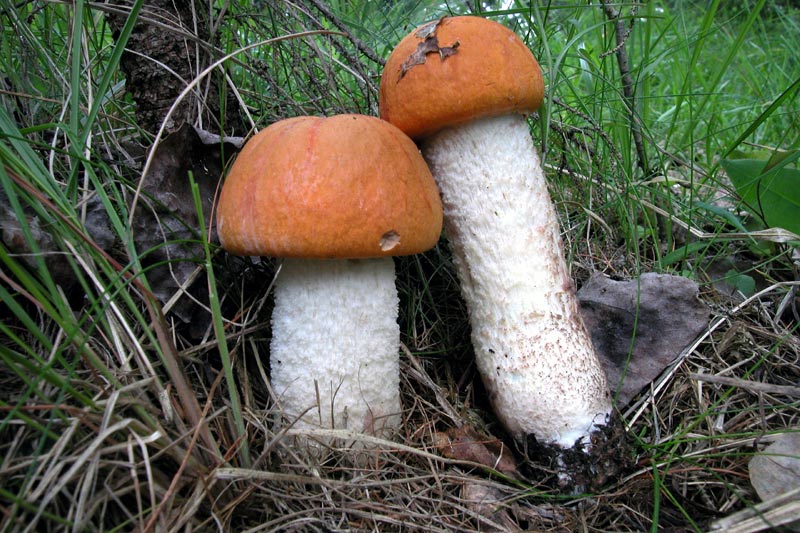
Boletus aurantiacus is 8-16 cm across, orange to apricot, brown, smooth or slightly downy-fibrillose, cuticle overhanging tubes as an irregular skirt up to 3mm deep. Stem 80-140 x 18-48 mm, initially covered in white scales which gradually turn rusty then dark brown. Flesh cream turning vinaceous in cap and stem base and sepia elsewhere. Taste and smell pleasant. Tubes white, vinaceous on exposure to air. Pores very small, white or cream bruising vinaceous. Spore print ochraceous buff. Spores subfusiform, 14-16.5 x 4-5 μm.
Blue Beech, Hornbeam (Leccinum carpini, Leccinum pseudoscabrum)

Pileus 3-12 cm; convex becoming broadly convex; surface dry, glabrous or nearly so; often rugose or rugulose; sometimes becoming areolate with age; yellowish brown, reddish brown, or, most commonly, gray-brown to dark brown or nearly black, sometimes with olive or greenish tinges; without a substantial sterile margin. Context whitish; soon gray to blackish when sliced and exposed to air, sometimes after a pinkish to purplish stage. Tubes to 20 mm long; whitish to grayish at first, developing yellowish and/or olive shades; pore surface whitish to pale grayish, developing yellowish or olive overtones with age, bruising brownish to yellowish or olive, depressed at the stipe; 1-2 more or less round pores per mm. Stipe 4-13 cm long; 6-14 mm wide at apex; slightly tapered to apex; whitish to grayish; densely scabrous with fine, brown to brownish black scabers; sometimes bruising or discoloring greenish near the base; basal mycelium white. Odor and taste not distinctive. Spore print cinnamon brown to brown. Exsiccata) with medium grayish brown pilei, frequently conspicuously areolate with pale context exposed; hymenia brown with orangish or reddish tinges; stipe surfaces tan to off-white near the base, covered with very fine medium brown to blackish brown scabers.
Slate Bolete (Leccinum duriusculum)
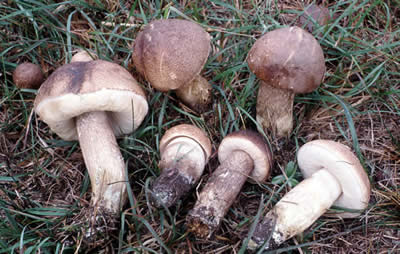
Cap 6-15 cm, light cinnamon-buff, slightly downy to somewhat stippled, becoming smoother with age, cuticle overhanging tubes. Stem 80-140 x 20-35 mm, white at apex, buff towards the base, ornamented with black or brown-black scales, often tinged blue-green near the base. Flesh firm, white, pink or peach in the cap, vinaceous grey in the stem apex and with touches of blue-green fading brownish in the stem base, finally blotched blackish throughout. Taste and smell not distinctive. Tubes whitish then pale yellowish. Pores small, round, whitish bruising olive brown. Spore print snuff-brown. Spores subfusiform, 14.5-16 x 4.5-6 μm.
Ghost Bolete (Leccinum holopus)
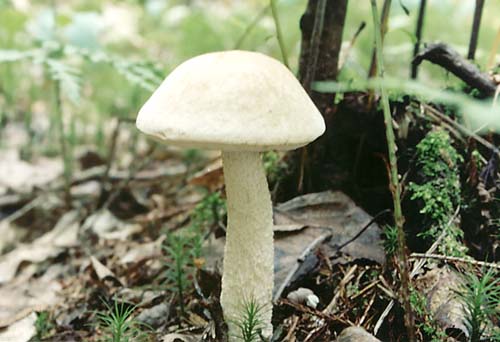
Cap 5-12 cm across, broadly convex; white then soon pallid buff to olivaceous or pinkish buff at disc, sometimes more greenish; glabrous, dry, then slightly viscid with age. Tubes deeply depressed around stem; white then brownish. Pores small; white staining yellowish when bruised. Stem 60-120 x 10-15 mm, long, cylindric; pallid, whitish below a darker blackish-brown ornamentation of fine dots and squamules, slowly staining reddish to gray. Flesh firm and white when young, soon soft and cut surface staining reddish with grayish streaks. Odor not distinctive. Taste not distinctive. Spores subfusiform, 14-19 x 5-6 μm. Deposit cinnamon brown.
Leccinum insigne
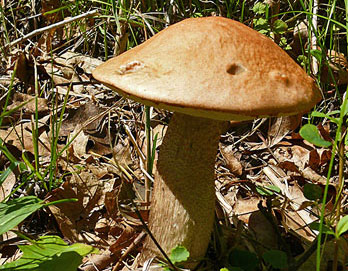
Cap 4-16 cm across, round to broadly convex becoming flatter; color varies from bright orange to reddish brown or brown, often paler and duller in age; dry, smooth or minutely hairy and sometimes scaly, then pitted in age. Tubes adnate or decurrent; whitish then olive-gray bruising pinkish brown. Pores whitish bruising yellow to olive-brown. Stem 60-150 x 10-25 mm, solid, swollen at the base; whitish when young, but covered with numerous small projecting scales which turn from reddish brown to blackish in age, base often bruises blue; tough, fibrous. Flesh thick, soft; white turning violet-gray or dingy brown when cut. Spores spindle-shaped to ellipsoid, smooth, 11-18 x 4-6 μm. Deposit brownish or yellowish-brown.
Orange Oak Bolete (Leccinum quercinum)

Cap 6-15 cm, chestnut to date-brown, fibrillose scaly, becoming smooth and more rusty, margin overhanging the pores. Stem 110-180 x 20-35 mm, pale brown to buff at apex with whitish scales becoming pale brown, stem whitish to buff towards base with whitish scales becoming rusty or purplish date, darkening on handling. Flesh white to cream rapidly pink or vinaceous in cap, more grey in the stem sometimes with a slight green flush in the base. Taste and smell pleasant. Tubes white to pale buff becoming vinaceous or cigar-brown. Pores small, similarly coloured. Spore print snuff-brown. Spores subfusiform, 12-15 x 3.5-5 μm.
Brown Birch Bolete (Leccinum scabrum)
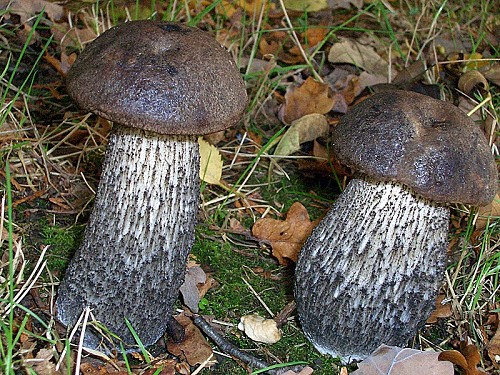
Cap 5.0-14.0 cm broad, convex, broadly convex in age with a decurved margin; surface when young, dingy-tan, dull, matted-tomentose, subviscid, occasionally areolate; at maturity sometimes weathering glabrous, becoming viscid, medium-brown to dull olive-brown; context soft, up to 1.5 cm thick, cream-colored, unchanging or occasionally faintly pink or blue where cut or injured; odor and taste mild.
Hymenophore: Pores cream-buff to pale tan, bruising pale olive-buff, deeply depressed at the stipe; tubes 1-2 cm long, pallid when young, in age pale coco-brown, unchanging when cut or bruised.
Stipe 8.0-14.0 cm long, 2.0-4.0 cm thick, clavate in youth, becoming subclavate to equal at maturity, solid, straight; surface of apex pruinose, pallid to cream, longitudinally ridged below, sometimes forming a coarse reticulum, ornamented with black squamules; partial veil absent.
Spores 14-18 x 5-6 μm, subfusoid to narrowly ellipsoid, smooth, thin-walled with variously-sized vacuolar inclusions; spore print dull brown.
Orange Birch Bolete (Leccinum versipelle)
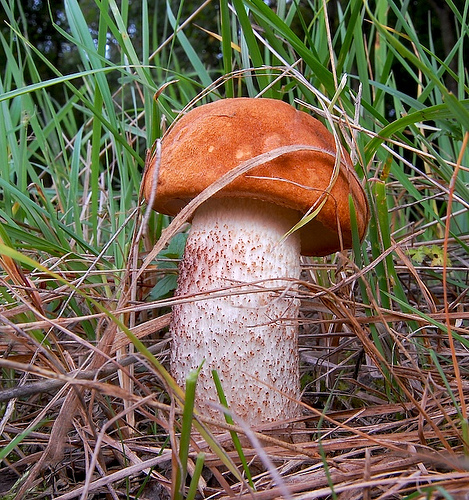
Cap 8-20 cm, tawny orange, slightly downy at first becoming smooth, dry to very slightly viscid, the margin overhanging the pores. Stem up to 200 x 15-40 mm, white or greyish covered with woolly brownish-black scales. Flesh white then dark vinaceous, but blue-green in stem base, finally blackish. Taste and smell pleasant. Tubes white to buff, vinaceous on cutting. Pores small, mouse-grey at first later ochraceous, bruising vinaceous. Spore print ochraceous snuff-brown. Spores subfusiform, 12.5-154-5 μm.
║ Mushrooms ║